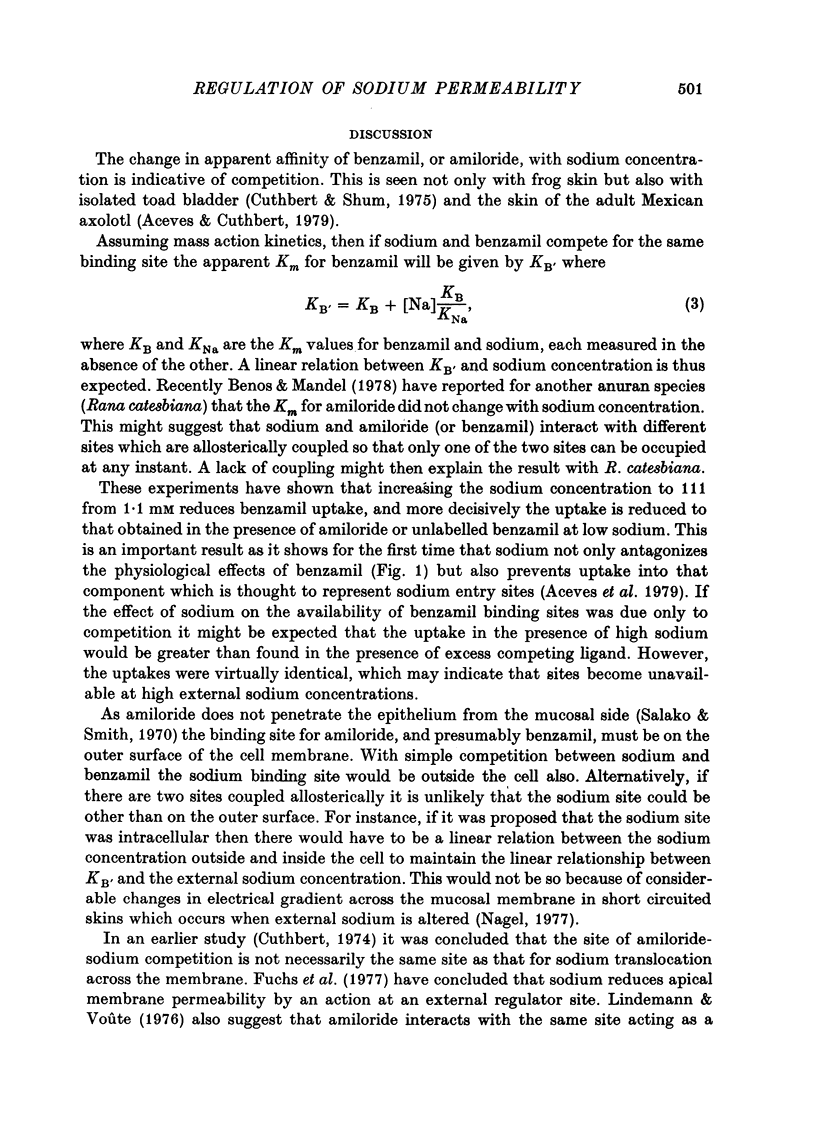Abstract
1. The effect of benzamil on short-circuit current in frog skin was measured at different external sodium concentrations. A linear relationship exists between the concentration of benzamil reducing short-circuit current by 50% and the external sodium concentration, indicative of some form of competitive antagonism between sodium and benzamil. 2. Uptake of [3H]benzamil into isolated frog skin epithelium and whole skin (0.95 cm2 pieces) was measured at different external sodium concentrations. With a sodium concentration of 111 mM in the external medium the uptake of [3H]benzamil is linear with concentration. Uptake amounted to 8.8 f-mole nM-1, a value similar to the linear component of the uptake measured at low (1.1 mM) sodium concentration. 3. Using a variety of other conditions the maximal number of specific binding sites for [3H]benzamil was calculated from displaceable binding and the fractional occupancy, the latter being derived from the inhibition of short-circuit current. This approach gave similar binding site densities to those reported previously at low sodium concentrations. 4. The reduction in specific [3H]benzamil uptake at high sodium may result from two mechanisms, competition of sodium with the ligand for an external binding site and a reduction in the site density as the intracellular sodium concentration increases. 5. It is concluded that the saturation of sodium transport which occurs at high sodium concentration is likely a consequence of the reduced availability of entry sites, rather than saturation of the uptake process.
Full text
PDF













Selected References
These references are in PubMed. This may not be the complete list of references from this article.
- Aceves J., Cuthbert A. W. Chloride-dependent sodium transport in the skin of Ambystoma mexicanum [proceedings]. J Physiol. 1979 Apr;289:79P–79P. [PubMed] [Google Scholar]
- Aceves J., Cuthbert A. W., Edwardson J. M. Estimation of the density of sodium entry sites in frog skin epithelium from the uptake of [3H]benzamil. J Physiol. 1979 Oct;295:477–490. doi: 10.1113/jphysiol.1979.sp012981. [DOI] [PMC free article] [PubMed] [Google Scholar]
- Biber T. U., Curran P. F. Direct measurement of uptake of sodium at the outer surface of the frog skin. J Gen Physiol. 1970 Jul;56(1):83–99. doi: 10.1085/jgp.56.1.83. [DOI] [PMC free article] [PubMed] [Google Scholar]
- CEREIJIDO M., HERRERA F. C., FLANIGAN W. J., CURRAN P. F. THE INFLUENCE OF NA CONCENTRATION ON NA TRANSPORT ACROSS FROG SKIN. J Gen Physiol. 1964 May;47:879–893. doi: 10.1085/jgp.47.5.879. [DOI] [PMC free article] [PubMed] [Google Scholar]
- Cuthbert A. W. An upper limit to the number of sodium channels in frog skin epithelium. J Physiol. 1973 Feb;228(3):681–692. doi: 10.1113/jphysiol.1973.sp010106. [DOI] [PMC free article] [PubMed] [Google Scholar]
- Cuthbert A. W., Fanelli G. M. Effects of some pyrazinecarboxamides on sodium transport in frog skin. Br J Pharmacol. 1978 May;63(1):139–149. doi: 10.1111/j.1476-5381.1978.tb07783.x. [DOI] [PMC free article] [PubMed] [Google Scholar]
- Cuthbert A. W., Shum W. K. Characteristics of the entry process for sodium in transporting epithelia as revealed with amiloride. J Physiol. 1976 Mar;255(3):587–604. doi: 10.1113/jphysiol.1976.sp011297. [DOI] [PMC free article] [PubMed] [Google Scholar]
- Cuthbert A. W., Shum W. K. Effects of vasopressin and aldosterone on amiloride binding in toad bladder epithelial cells. Proc R Soc Lond B Biol Sci. 1975 Jun 17;189(1097):543–575. doi: 10.1098/rspb.1975.0072. [DOI] [PubMed] [Google Scholar]
- Erlij D., Smith M. W. Sodium uptake by frog skin and its modification by inhibitors of transepithelial sodium transport. J Physiol. 1973 Jan;228(1):221–239. doi: 10.1113/jphysiol.1973.sp010083. [DOI] [PMC free article] [PubMed] [Google Scholar]
- Fuchs W., Larsen E. H., Lindemann B. Current-voltage curve of sodium channels and concentration dependence of sodium permeability in frog skin. J Physiol. 1977 May;267(1):137–166. doi: 10.1113/jphysiol.1977.sp011805. [DOI] [PMC free article] [PubMed] [Google Scholar]
- Lewis S. A., Eaton D. C., Diamond J. M. The mechanism of Na+ transport by rabbit urinary bladder. J Membr Biol. 1976 Aug 27;28(1):41–70. doi: 10.1007/BF01869690. [DOI] [PubMed] [Google Scholar]
- Lindemann B., Van Driessche W. Sodium-specific membrane channels of frog skin are pores: current fluctuations reveal high turnover. Science. 1977 Jan 21;195(4275):292–294. doi: 10.1126/science.299785. [DOI] [PubMed] [Google Scholar]
- Nagel W. The dependence of the electrical potentials across the membranes of the frog skin upon the concentration of sodium in the mucosal solution. J Physiol. 1977 Aug;269(3):777–796. doi: 10.1113/jphysiol.1977.sp011929. [DOI] [PMC free article] [PubMed] [Google Scholar]
- Salako L. A., Smith A. J. Changes in sodium pool and kinetics of sodium transport in frog skin produced by amiloride. Br J Pharmacol. 1970 May;39(1):99–109. doi: 10.1111/j.1476-5381.1970.tb09559.x. [DOI] [PMC free article] [PubMed] [Google Scholar]
- Turnheim K., Frizzell R. A., Schultz S. G. Interaction between cell sodium and the amiloride-sensitive sodium entry step in rabbit colon. J Membr Biol. 1978 Mar 10;39(2-3):233–256. doi: 10.1007/BF01870333. [DOI] [PubMed] [Google Scholar]
- Zeiske W., Lindemann B. Chemical stimulation of Na + current through the outer surface of frog skin epithelium. Biochim Biophys Acta. 1974 Jun 13;352(2):323–326. doi: 10.1016/0005-2736(74)90223-5. [DOI] [PubMed] [Google Scholar]


